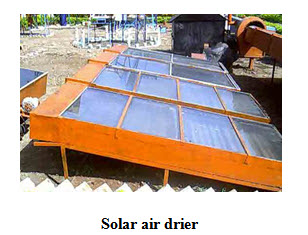Site pages
Current course
Participants
General
Module 1. Design and operational parameters
Module 2. Performance evaluation and maintenance a...
Module 3. Performance evaluation and maintenance a...
Module 4. Performance evaluation and maintenance a...
Module 5. Performance evaluation and maintenance a...
Module 6. Performance evaluation and maintenance a...
Module 7. Biodiesel utilization in CI engines
Lesson 15. Constructional details of solar passive heating devices
Parameters affecting performance of solar passive heating devices
The principle of solar thermal energy system includes transmission of solar radiation through transparent cover and allowing the radiation to fall on an absorber surface, which will convert the solar radiation into heat. Flat plate collectors are the most common type of collectors which consist of
i. black coated absorber plate
ii. transparent cover
iii. heat transfer fluid (air or water)
iv. heat insulating enclosure

Applications of solar thermal energy
Using various combinations of solar radiation to heat conversion devices and heat storage devices, several application of solar thermal energy are possible. These are listed below:
-
Cooking
-
Water heating
-
Distillation
-
Drying
-
Refrigeration
-
Power generation

Parameters affecting solar thermal devices performance
The performance of a solar still is affected by parameters such as environmental conditions, design parameters and operating parameters. The environmental conditions such as solar insolation, atmospheric temperature, wind speed, cloudiness etc. The design parameters consist of nature of absorber plate and coating, inclination of the collector, thermo-physical properties of materials used, number of glass cover(s), insulation material etc. The operating parameters consist of flow rate of fluid, quality of water, initial fluid temperature etc. These parameters have significant effect on the performance of the solar passive heating systems.
Solar insolation
The solar thermal system output is mainly dependent on the amount of solar radiation falling on the dryer in a given location. Higher the solar insolation, higher will be the heat energy available in the solar radiation. Hence, the heat energy transferred to the fluid will be more and the performance of the thermal system will be better.
Atmospheric temperature
At higher atmospheric temperature, the energy transmitted into the solar thermal system will be higher. As well as, the higher temperature reduces the transfer of heat from the thermal system to the atmosphere and hence, the heat loss will be minimized.
Wind speed
Wind has direct effect on heat loss from the thermal systems. Higher wind speed reduced the available heat energy falling on the transparent cover and reduces temperature on the glass cover. Hence, the performance of the thermal system will be affected at higher wind velocity.
Inclination of collector
Optimum inclination of collector will be resulted to higher transmission of solar radiation and in turn provides higher thermal energy for further application. Normally, the inclination should be 10 to 15° addition to the latitude of the location. The transparent cover should possess better transmissivity to allow maximum possible solar radiation in to the solar thermal system. The slope should provide easy runoff of rain water during rainy season.
Absorber plate
Absorber material and coating has greater effect on absorption of solar radiation transmitted through transparent cover and should provide maximum conversion into thermal energy. Also, it has to transfer the available heat energy to the air / water for further applications. Selective coatings are available for better thermal conversion of absorber plates. The absorptivity of the absorber plate has to be higher for better performance of the gadget.
Number of glass cover(s)
The number of transparent covers should be optimized so as to transmit maximum solar radiation and minimize the transmission of long wave heat energy generated in side the solar collector to the atmosphere.
Insulation
The insulation materials have influence on over all heat loss coefficient. Better the insulation of material, lesser will be the heat loss from the thermal collector to atmosphere.
Fluid flow rate
The working fluids such as air in dryers and water in water heaters, transfer heat from the collector to further application. If the flow rate is optimum, maximum heat transfer can be effected. Lesser the flow rate, lesser will be the heat transfer and there may be unused heat energy left in the collectors. If the flow rate is higher, the heat transfer will be faster and the energy intensity of the fluid may be lesser and in turn which will affect the performance of the solar collector.